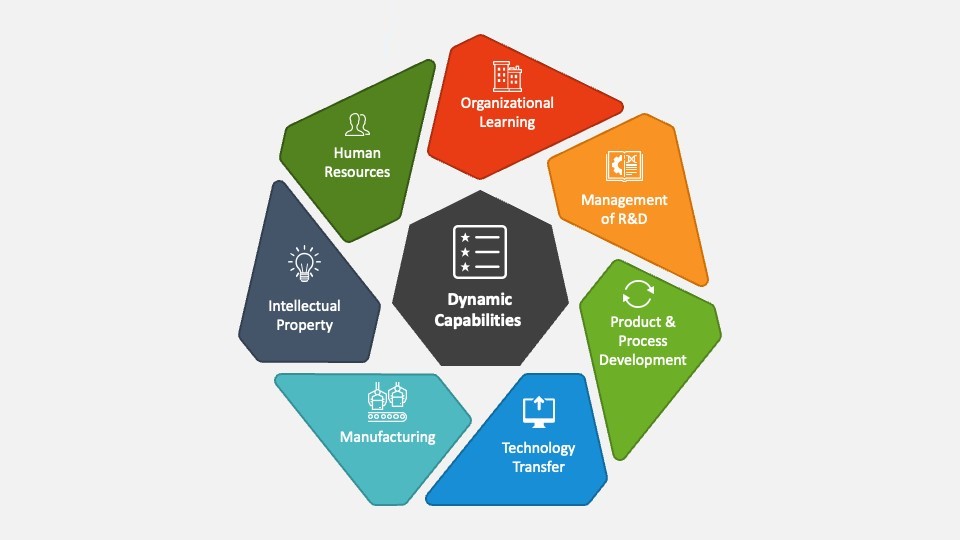
The Dynamic Capabilities Framework was first introduced by David Teece in the 1990s. Teece argued that organizations must continuously develop, renew, and reconfigure their resources and capabilities to succeed in dynamic and uncertain environments. Unlike traditional resource-based strategies, which emphasize static assets like patents or equipment, the Dynamic Capabilities Framework focuses on the organization’s ability to adapt and evolve. Companies that master this framework can thrive by responding effectively to market shifts, technological advancements, and changes in consumer behavior.
What is the Dynamic Capabilities Framework?
The Dynamic Capabilities Framework emphasizes three main pillars: sensing opportunities, seizing opportunities, and transforming the organization. First, companies need to identify and anticipate shifts in the market or industry by gathering intelligence and interpreting data. This allows businesses to stay ahead of trends and avoid being blindsided by disruptive forces. Second, companies must have the agility to seize these opportunities by allocating resources and reconfiguring their operations to capture new value. Finally, transforming involves the ongoing ability to reconfigure and realign internal processes, systems, and resources to maintain strategic flexibility.
For companies to effectively use the Dynamic Capabilities Framework, they must focus on enhancing their ability to learn and evolve. This requires a deep understanding of their internal resources, including human capital, technology, and organizational processes. Firms that are highly adaptable can pivot quickly when new opportunities or threats arise. Furthermore, fostering a culture of continuous learning and innovation is critical for developing dynamic capabilities, allowing businesses to stay competitive in uncertain markets.
Why Dynamic Capabilities Matter
In today’s rapidly evolving business environment, the need for adaptability cannot be overstated. Companies face increasing pressures from technological advancements, shifting customer preferences, and global competition. Businesses that rely solely on traditional capabilities risk becoming obsolete. The Dynamic Capabilities Framework provides a solution by emphasizing the importance of flexibility and continuous adaptation. Companies with strong dynamic capabilities can anticipate changes and proactively adjust their strategies, positioning themselves to capitalize on emerging opportunities.
Moreover, organizations with dynamic capabilities are more resilient to shocks and disruptions. Whether dealing with technological breakthroughs, regulatory changes, or market volatility, these companies can realign their strategies quickly to maintain a competitive edge. For example, during the COVID-19 pandemic, companies with dynamic capabilities were able to swiftly pivot their operations to meet new consumer demands, such as shifting to digital platforms or reconfiguring supply chains to cope with disruptions.
Another key benefit of the Dynamic Capabilities Framework is its focus on innovation. Businesses that prioritize dynamic capabilities encourage experimentation and risk-taking, which are essential for fostering innovation. By continuously sensing market trends and customer needs, companies can develop new products and services that meet emerging demands. This constant innovation is crucial in industries where consumer preferences shift quickly, such as technology and retail.
Building Dynamic Capabilities
To build dynamic capabilities, organizations must focus on fostering a culture of learning, collaboration, and adaptability. One of the first steps is to invest in employee training and development. A workforce that is skilled in identifying opportunities and adapting to new processes is critical for maintaining flexibility. Additionally, companies need to create cross-functional teams that can work together to respond to changes in the market. These teams should be empowered to make decisions quickly and reconfigure processes when necessary.
Another essential element is the use of data and analytics to drive decision-making. Sensing opportunities requires businesses to collect, analyze, and interpret data from multiple sources, including customer feedback, market research, and technological trends. Companies with strong data capabilities can anticipate market shifts and act on them before competitors. By leveraging data, businesses can ensure that their dynamic capabilities are grounded in real-time insights and can drive strategic decisions.
Furthermore, leadership plays a crucial role in building dynamic capabilities. Leaders must create an organizational structure that supports agility, fostering a culture where change is seen as an opportunity rather than a threat. By encouraging open communication, collaboration, and innovation, leaders can help their teams adapt to new challenges and seize opportunities. The leadership team should actively invest in the resources needed for transformation, whether by acquiring new technology or developing workforce skills.
Challenges
While the Dynamic Capabilities Framework offers significant advantages, it is not without its challenges. One of the most significant obstacles to developing dynamic capabilities is organizational inertia. Many companies struggle to break free from their established routines and processes, even when it is clear that change is necessary. Overcoming this inertia requires strong leadership and a willingness to disrupt the status quo. Leaders must encourage a mindset of continuous improvement and align employees with the company’s strategic vision.
Another challenge is the need for constant investment in new resources and capabilities. Building dynamic capabilities requires ongoing training, technology upgrades, and process reconfiguration, all of which can be costly. However, organizations that invest in these areas will find that the long-term benefits of adaptability and innovation far outweigh the short-term costs. Companies must balance the need for agility with the realities of resource constraints, ensuring that they prioritize the areas that will have the greatest impact on their long-term success.
Finally, maintaining a balance between operational efficiency and strategic flexibility can be difficult. While it is important to stay flexible and open to change, companies also need to maintain efficient processes and systems. To strike this balance, leaders must understand clearly which business areas they should standardize for efficiency and which they need to keep flexible to adapt to market changes.
Conclusion
The Dynamic Capabilities Framework is a critical tool for businesses operating in today’s fast-paced, ever-changing environment. By focusing on the ability to sense opportunities, seize them, and continuously transform the organization, companies can stay competitive and resilient in the face of uncertainty. Building dynamic capabilities requires investment in people, processes, and technology, as well as a commitment to fostering a culture of innovation and learning. While the challenges are significant, the rewards of mastering the Dynamic Capabilities Framework far outweigh the costs. As businesses continue to navigate increasingly complex and competitive markets, dynamic capabilities will remain a cornerstone of sustainable success.

